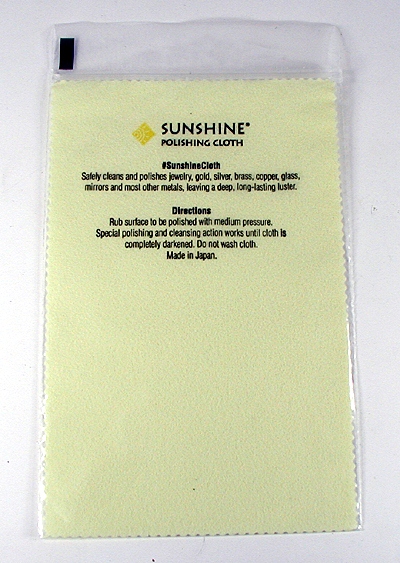We often get vintage pieces in that have a wonderful patina but also a dash of Alfredo sauce or leftover silver polish in the nooks and crannies.
So how do we clean while preserving the endearing patina?
When we sell vintage pieces, we usually just leave them as is so the new owner can clean them to their personal taste.
But if there is dirt and debris in the stamping or silver work, we remove that. Usually a dry toothbrush and a wooden toothpick is all that is needed.

Loosen debris with a wooden toothpick

Brush with a dry toothbrush

Brushed clean
With my personal more contemporary sterling silver pieces (no stones), if I want to restore a brilliant shine, I either buff with a polishing cloth

Or use the procedure outlined in “Richard’s Method”.
IMPORTANT NOTES !! Great care should be taken when cleaning any sterling silver piece with stones. The pieces should NEVER be soaked as this would swell the backing (which is often sawdust or leather) and pop the stones out of their settings or damage them.
For sterling silver jewelry with stones and for pieces that I want to retain much of the vintage patina, I usually use a simple wash, dry and light hand buff combo. I use ordinary liquid hand soap (not antibacterial – something more like liquid Ivory) on a cloth or soft toothbrush to loosen debris and clean both the front and back of bracelets and pendants. Then I rinse it well but carefully, avoiding the stone settings. I follow this with a thorough drying and then token hand buffing with a silver polishing cloth. I stop at the point where the item is clean but still has its character.
I use a polishing cloth to maintain the shine in my new beads but if the oxidation gets ahead of me, I spritz them with Windex, taking care not to use too much because I don’t want it to run into the holes. I lightly spritz one section and then wipe right away. Less is more.
When Diane Radeke’s repair service was in the process of restringing an old squash blossom necklace for me (the subject of another blog on repair), the topic of cleaning came up and here is what Diane had to say:
While your necklace is disassembled, we’d like to wash the naja and blossoms. As you are definitely in favor of original patina, I want to explain this and get your approval first. I meet many, many people who do not want the surface of their silver touched in any way, not even to be cleaned. To me, there is a big difference in being “cleaned”, being “polished”, and being “buffed”. It’s mostly semantics, but I think there is a lot of confusion about what might be the best way to treat a piece of jewelry.
To me, buffing is something done with a buffing machine, in the shop. Buffing actually smooths the surface of the silver, and removes all those tiny fine lines and scratches that create the soft, beautiful look of a well worn piece. With very few exceptions, I don’t like to see anything buffed. The exceptions would be for pieces that are very contemporary or have a very bad scratch that detracts from the piece. A very few people like their pieces buffed smooth, regardless of the age or history of the piece.
Tiny fine lines and scratches can be replicated by working the surface with steel wool, but a trained eye will spot it every time. It can look nice, but it’s not “patina”… If a piece must be hot soldered for a repair, it must go through the buffing process – no way around it. Our smiths are awesome, but that is one of their biggest challenges – hot soldering on a vintage piece and retaining the “look”.
Polishing is using a chemical agent to clean the blackened tarnish from a piece of silver. Polishing (in my phraseology) doesn’t remove the scratches at all, but it can remove the oxidation that may have been applied to enhance the design of a piece. Oxidation can be very successfully reapplied (chemically) BUT most polishes will leave nasty residues in all the lovely details of this beautiful handmade stuff. The residue turns white or green or pink. One of the few chemical “polishers” that doesn’t leave a residue (Tarnax) will actually dissolve turquoise and coral, among other things. I can’t tell you how many Tarnax victims we’ve repaired here. Polishing with any of this chemical stuff is really intended only for flatter manufactured pieces, like silverware, and even then, just cleaning it will frequently work better.
So, my favorite and most suggested technique is cleaning. A good washing (done properly, of course) will remove all the gunk, label residue, polish residue, grime, dust, cookie dough (yes we’ve removed that) and any other surface stuff that “shouldn’t be there”. The result is a piece that still has all the fine scratches, oxidation, and beauty (the “patina”) of an old piece, but it will show with a beautiful true silver glow, instead of a flat yellow gray appearance. In my opinion, it really enhances the piece.
We generally wash using the Tide Detergent technique (listed in the comments following the Richard’s Method article) and a soft toothbrush. Then we dry very thoroughly with a cloth which creates just a little bit of a glow.
We don’t wash beads, because they’re too hard to dry out properly. We would wipe them with a cotton glove only.
Thank you Diane for your contribution to this article – Paula

























